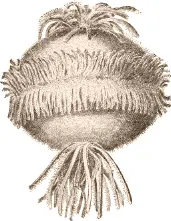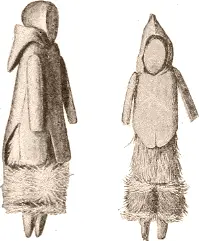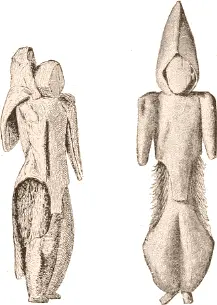
Fig. 526. Ball. (Museum für Völkerkunde, Berlin. IV A 6822.)
The ball (Fig. 526) is most frequently used in summer. It is made of sealskin stuffed with moss and neatly trimmed with skin straps. One man throws the ball among the players, whose object it is to keep it always in motion without allowing it to touch the ground. Another game of ball I have seen played by men only. A leather ball filled with hard clay is propelled with a whip, the lash of which is tied up in a coil. Every man has his whip and is to hit the ball and so prevent his fellow players from getting at it.
A third game at ball called igdlukitaqtung is played with small balls tossed up alternately from the right to the left, one always being in the air. Songs used in the game will be found in the last pages of this paper.
An amusement of women and children is to point successively on the forehead, the cheek, and the chin and to pronounce as rapidly as possible sulubautiχu´tika, tudliχu´tika, tadliχu´tika, tudliχú´tika, i.e., the forehead, the cheek, the chin, the cheek.
Young children play with toy sledges, kayaks, boats, bows and arrows, and dolls. The last are made in the same way by all the tribes, a wooden body being clothed with scraps of deerskin cut in the same way as the clothing of men. Fig. 527 shows dolls in the dress of the Oqomiut; Fig. 528, in that of the Akudnirmiut.

Fig. 527. Dolls in dress of the Oqomiut. (Museum für Völkerkunde, Berlin. IV A 6702.) 1/1

Fig. 528. Dolls in dress of the Akudnirmiut. (Museum für Völkerkunde, Berlin. IV A 6702.) 1/1
In summer children and grown up people exercise by sitting down on their knees in a large circle and simultaneously jumping up and down, by kneeling and holding their toes in their hands and trying to outdo one another in running in this position, &c.
A favorite amusement during the long winter nights is telling tales and composing songs. Old traditions are always related in a highly ceremonious manner. The narrator takes off his outer jacket, pulls the hood over his head, and sits down in the rear part of the hut, turning his face toward the wall, and then tells the story slowly and solemnly. All the stories are related in a very abridged form, the substance being supposed to be known. The form is always the same, and should the narrator happen to say one word otherwise than is customary he will be corrected by the listeners.
Children tell one another fables and sing short songs. Comic songs making fun of any person are great favorites. Details on the poetry and music of the Eskimo will be found further on.
Parry’s description of the games and sports practiced by the Iglulirmiut is so interesting that I insert it here (II, p. 538):
On an occasion when most of the men were absent from the huts on a sealing excursion, the women joined in playing, one of them being the chief performer. Being requested to amuse the rest, she suddenly unbound her hair, platted it, tied both ends together to keep it out of her way, and then stepping out into the middle of the hut, began to make the most hideous faces that can be conceived, by drawing both lips into her mouth, poking forward her chin, squinting frightfully, occasionally shutting one eye, and moving her head from side to side as if her neck had been dislocated. This exhibition, which they call ajokitarpoq, and which is evidently considered an accomplishment that few of them possess in perfection, distorts every feature in the most horrible manner imaginable, and would, I think, put our most skillful horse-collar grinners quite out of countenance.
This performance is identical with one described later ( p. 578) as practiced during the meals in summer.
The next performance consists in looking steadfastly and gravely forward and repeating the words tăbā’-tăbā’; kjaibo, kjaibo; kebang inutovik, kebang inutovik; amatama, amatama, in the order in which they are here placed, but each at least four times, and always by a peculiar modulation of the voice speaking them in pairs as they are coupled above. The sound is made to proceed from the throat in a way much resembling ventriloquism, to which art it is indeed an approach. After the last amatama she always pointed with her finger toward her body, and pronounced the word angakoq, steadily retaining her gravity for five or six seconds, and then bursting into a loud laugh, in which she was joined by all the rest. The women sometimes produce a much more guttural and unnatural sound, repeating principally the word ikeri-ikeri, coupling them as before, and staring in such a manner as to make their eyes appear ready to burst out of their sockets with the exertion. Two or more of them will sometimes stand up face to face, and with great quickness and regularity respond to each other, keeping such exact time that the sound appears to come from one throat instead of several. Very few of the females are possessed of this accomplishment, which is called pitkusiraqpoq, and it is not uncommon to see several of the younger females practising it. A third part of the game, distinguished by the word kaitikpoq, consists only in falling on each knee alternately, a piece of agility which they perform with tolerable quickness, considering the bulky and awkward nature of their dress. ***Then the same woman came forward, and letting her arms hang down loosely and bending her body very much forward, shook herself with extreme violence, as if her whole frame had been strongly convulsed, uttering at the same time, in a wild tone of voice, some of the unnatural sounds before mentioned.
This being at an end, a new exhibition was commenced in which ten or twelve women took a part, and which our gentlemen compared to blind man’s buff. A circle being formed, and a boy dispatched to look out at the door of the hut, a woman placed herself in the center, and, after making a variety of guttural noises for about half a minute, shut her eyes, and ran about till she had taken hold of one of the others, whose business it then became to take her station in the center, so that almost every woman in her turn occupied this post, and in her own peculiar way, either by distortion of countenance or other gestures, performed her part in the game. This continued three-quarters of an hour, and, from the precaution of placing a lookout who was withdrawn when it was over, as well as from some very expressive signs which need not here be mentioned, there is reason to believe that it is usually followed by certain indecencies, with which their husbands are not to be acquainted. ***
The most common amusement however, and to which their husbands made no objection, they performed at Winter Island expressly for our gratification. The females, being collected to the number of ten or twelve, stood in as large a circle as the hut would admit, with a man in the center. He began by a sort of half howling, half singing noise, which appeared as if designed to call the attention of the women, the latter soon commencing the Amna Aya song. This they continued without variety, remaining quite still while the man walked round within the circle; his body was rather bent forward, his eyes sometimes closed, his arms constantly moving up and down, and now and then hoarsely vociferating a word or two as if to increase the animation of the singers, who, whenever he did this, quitted the chorus and rose into the words of the song. At the end of ten minutes they all left off at once, and after one minute’s interval commenced a second act precisely similar and of equal duration, the man continuing to invoke their muse as before. A third act which followed this, varied frequently towards the close only in his throwing his feet up before and clapping his hands together, by which exertion he was thrown into a violent perspiration. He then retired, desiring a young man (who as we were informed was the only individual of several then present thus qualified) to take his place in the center as master of the ceremonies, when the same antics as before were again gone through. After this description it will scarcely be necessary to remark that nothing can be poorer in its way than this tedious singing recreation, which, as well as in everything in which dancing is concerned, they express by the word mumipoq. They seem, however, to take great delight in it; and even a number of the men as well as all the children crept into the hut by degrees to peep at the performance.
Читать дальше















